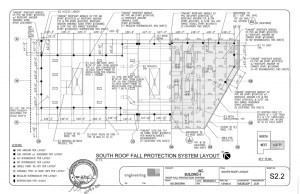
Design and Engineering
Design:
At Atlantic Fall Protection, we develop compliant designs that promote safety and worker productivity. Designs are drawn in Auto CAD, which ensures that the recommended layout will realistically function on the proposed building or structure. Our fall protection systems follow the guidelines and laws put in place by OSHA and ANSI. We utilize both manufactured “off the shelf” products as well as custom fabricated parts to design systems that will adapt to the specific need. Whether it is a system of guardrails or a complex horizontal lifeline, the first step in the process of developing a fall protection system is an effective design.
Engineering:
Atlantic Fall Protection systems are designed and engineered by certified professional engineers with extensive knowledge in the fall protection industry. It is important to know that simply installing a pre-engineered “off the shelf” fall protection system does not make it safe, compliant, or an engineered system. All elements of a fall protection system must be engineered for each specific condition including the structure it is attached to. Atlantic Fall Protection provides wet stamped engineered drawings and calculations with each fall protection system.


Wet stamped engineering is included with all engineered fall protection projects.
Engineering is required by OSHA law as stated below:
Relevant ANSI and OSHA Standards:
•29 CFR 1926.502(d)(8) Horizontal lifelines shall be designed, installed, and used, under the supervision of a qualified person, as part of a complete personal fall arrest system, which maintains a safety factor of at least two.
• 29 CFR 1926.502(d)(15) Anchorages used for attachment of personal fall arrest equipment shall be independent of any anchorage being used to support or suspend platforms and capable of supporting at least 5,000 pounds (22.2 kN) per employee attached, or shall be designed, installed, and used as follows:
29 CFR 1926.502(d)(15)(i) as part of a complete personal fall arrest system which maintains a safety factor of at least two; and
29 CFR 1926.502(d)(15)(ii) under the supervision of a qualified person.
• 29 CFR 1926.32(l) states: “Qualified” means one who, by possession of a recognized degree, certificate, or professional standing, or who by extensive knowledge, training and experience, has successfully demonstrated his ability to solve or resolve problems relating to the subject matter, the work, or the project.

